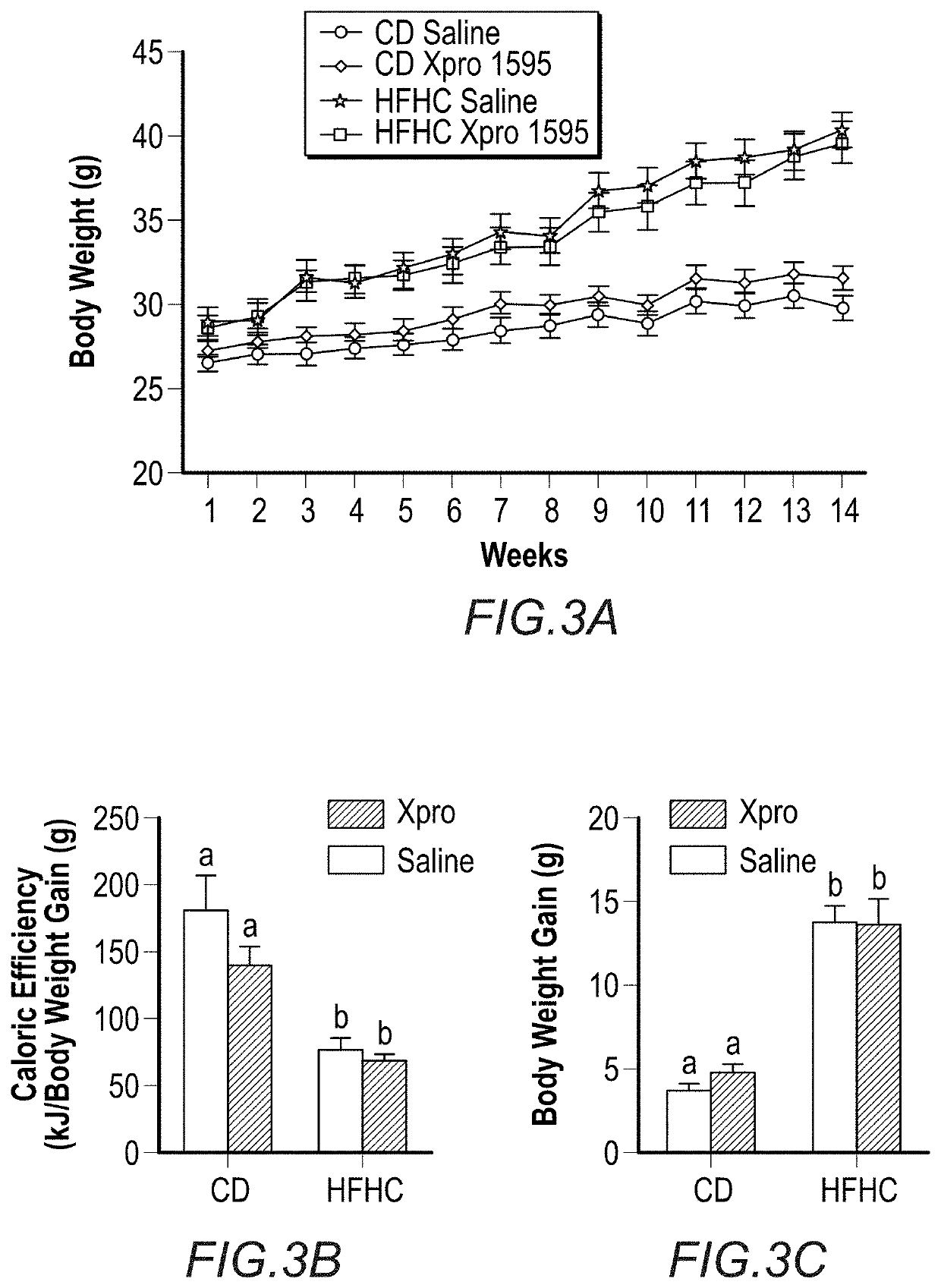Method for treating complications related to acute or chronic hyperglycemia
- Summary
- Abstract
- Description
- Claims
- Application Information
AI Technical Summary
Benefits of technology
Problems solved by technology
Method used
Image
Examples
example 1
Soluble TNF Neutralization Decreases Insulin and LCN2 Plasma Levels in Diet-Induced Metabolic Inflammation
[0177]A previously published diet-induced obesity (DIO) animal model was used with minor modifications to assess the peripheral and central effects of a high-fat high-carbohydrate (HFHC) diet and solTNF neutralization in obesity (Maria Elizabeth de Sousa Rodrigues et al., Brain Behav Immun. 2017 January; 59: 158-172). As expected, as shown in FIG. 3A, high-fat, high-carbohydrate (HFHC)-fed mice exhibited significant body-weight gain compared to control diet (CD) groups starting in the third week of diet treatment. Fourteen weeks of HFHC diet consumption was associated with reduced caloric efficiency (FIG. 3B) (p<0.0001), increased body-weight gain (p<0.0001) (FIG. 3C) and weight of retroperitoneal (p<0.0001) and gonadal fat pads (p<0.0001) (FIGS. 3D-E). HFHC diet decreased mesenteric tissue weight (p<0.0001) in both HFHC diet / Saline and HFHC diet / XPRO1595 groups (FIG. 3F).
[0178]...
example 2
SolTNF Inhibition Decreases Colonic LCN2 and Tight Junction Protein Alterations Associated with HFHC Diet
[0179]Having observed differences in colon (p<0.0001) and small intestine lengths (p<0.0001) associated with HFHC diet consumption (FIG. 3G-H), the potential of DIO to promote alterations in the intestinal environment and the ability of solTNF neutralization to reverse those changes was investigated. Animals exposed to HFHC diet developed an inflammatory colonic profile demonstrated by elevated colonic (p=0.0091) and fecal (p=0.0252) LCN2 and IL-1β mRNA expression (p<0.0001) (FIGS. 5A-C). There was a detectable XPRO1595 effect (p=0.0460) of decreasing colonic LCN2 in HFHC diet but not in the CD group (FIG. 5A). Strong positive correlations between colonic LCN2 and plasma LCN2 (r=0.51, p=0.003), and colonic LCN2 and liver LCN2 (r=0.6603, p=0.0005), and plasma LCN2 were observed. (FIG. 6A-B).
[0180]In addition to these inflammatory changes, the HFHC diet and XPRO1595 interaction imp...
example 3
SolTNF Inhibition Reduces Hepatic LCN2 Levels in the Presence of Diet-Induced Liver Inflammation
[0181]To gain further insight into the resultant immune alterations present in the gut-liver axis, hepatic LCN2 levels and the expression of inflammatory factors in the liver tissue were assessed. HFHC diet-fed mice developed elevated concentrations of hepatic LCN2 (p=0.034), and a significant interaction between diet and XPRO1595 treatment was found (p=0.0034), with LCN2 levels in the HFHC diet / XPRO1595 group indistinguishable from the CD group (FIG. 7A). The hepatic inflammatory profile after 14 weeks of HFHC diet treatment was confirmed by an increase in hepatic Il-1b (p<0.0001) and Il-6 (p=0.0036) mRNA expression (FIG. 7B-C). Diet treatment raised Tlr2 (p=0.022) and decreased Ppara (p=0.034) mRNA expression compared to CD groups (FIG. 7D-E). XPRO1595 decreased Tlr2 expression in HFHC diet-treated mice to levels statistically indistinguishable from the CD group. XPRO1595 reduced Ppara ...
PUM
| Property | Measurement | Unit |
|---|---|---|
| Density | aaaaa | aaaaa |
| Density | aaaaa | aaaaa |
| Density | aaaaa | aaaaa |
Abstract
Description
Claims
Application Information
 Login to View More
Login to View More - R&D
- Intellectual Property
- Life Sciences
- Materials
- Tech Scout
- Unparalleled Data Quality
- Higher Quality Content
- 60% Fewer Hallucinations
Browse by: Latest US Patents, China's latest patents, Technical Efficacy Thesaurus, Application Domain, Technology Topic, Popular Technical Reports.
© 2025 PatSnap. All rights reserved.Legal|Privacy policy|Modern Slavery Act Transparency Statement|Sitemap|About US| Contact US: help@patsnap.com



